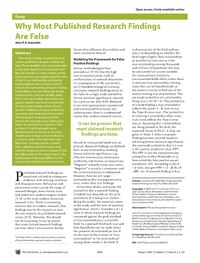
Impact of image preprocessing methods on reproducibility of radiomic features in multimodal magnetic resonance imaging in glioblastoma
Sign Up to like & getrecommendations! Published in 2019 at "Journal of Applied Clinical Medical Physics"
DOI: 10.1002/acm2.12795
Abstract: Abstract To investigate the effect of image preprocessing, in respect to intensity inhomogeneity correction and noise filtering, on the robustness and reproducibility of the radiomics features extracted from the Glioblastoma (GBM) tumor in multimodal MR… read more here.
Keywords: bias field; reproducibility; correction; radiomics features ... See more keywords

Comparison of three different correction trajectories for foot and ankle deformity treated by supramalleolar osteotomy using a novel external fixator.
Sign Up to like & getrecommendations! Published in 2020 at "International journal for numerical methods in biomedical engineering"
DOI: 10.1002/cnm.3400
Abstract: Based on the principle of distraction osteogenesis, external fixators are widely used in deformity correction of the foot and ankle. In this study, a novel ankle external fixator is proposed to correct complex multiplane deformities,… read more here.
Keywords: novel external; supramalleolar osteotomy; correction; fixator ... See more keywords

Evaluation of thresholding methods for activation likelihood estimation meta‐analysis via large‐scale simulations
Sign Up to like & getrecommendations! Published in 2022 at "Human Brain Mapping"
DOI: 10.1002/hbm.25898
Abstract: In recent neuroimaging studies, threshold‐free cluster enhancement (TFCE) gained popularity as a sophisticated thresholding method for statistical inference. It was shown to feature higher sensitivity than the frequently used approach of controlling the cluster‐level family‐wise… read more here.
Keywords: meta analysis; likelihood estimation; level; correction ... See more keywords

Optical coherence elastography for strain dynamics measurements in laser correction of cornea shape.
Sign Up to like & getrecommendations! Published in 2017 at "Journal of biophotonics"
DOI: 10.1002/jbio.201600291
Abstract: We describe the use of elastographic processing in phase-sensitive optical coherence tomography (OCT) for visualizing dynamics of strain and tissue-shape changes during laser-induced photothermal corneal reshaping, for applications in the emerging field of non-destructive and… read more here.
Keywords: optical coherence; phase; shape; cornea ... See more keywords

Fast shading correction for cone beam CT in radiation therapy via sparse sampling on planning CT
Sign Up to like & getrecommendations! Published in 2017 at "Medical Physics"
DOI: 10.1002/mp.12190
Abstract: Purpose The image quality of cone beam computed tomography (CBCT) is limited by severe shading artifacts, hindering its quantitative applications in radiation therapy. In this work, we propose an image‐domain shading correction method using planning… read more here.
Keywords: sparse sampling; radiation therapy; shading correction; correction ... See more keywords

Feasibility of real‐time motion management with helical tomotherapy
Sign Up to like & getrecommendations! Published in 2018 at "Medical Physics"
DOI: 10.1002/mp.12791
Abstract: PURPOSE This study investigates the potential application of image-based motion tracking and real-time motion correction to a helical tomotherapy system. METHODS A kV x-ray imaging system was added to a helical tomotherapy system, mounted 90… read more here.
Keywords: motion; system; motion correction; correction ... See more keywords

Calibration‐free beam hardening correction for myocardial perfusion imaging using CT
Sign Up to like & getrecommendations! Published in 2019 at "Medical Physics"
DOI: 10.1002/mp.13402
Abstract: Purpose Computed tomography myocardial perfusion imaging (CT‐MPI) and coronary CTA have the potential to make CT an ideal noninvasive imaging gatekeeper exam for invasive coronary angiography. However, beam hardening (BH) artifacts prevent accurate blood flow… read more here.
Keywords: image; myocardial perfusion; perfusion imaging; correction ... See more keywords

Paired cycle-GAN based image correction for quantitative cone-beam CT.
Sign Up to like & getrecommendations! Published in 2019 at "Medical physics"
DOI: 10.1002/mp.13656
Abstract: PURPOSE The incorporation of cone-beam CT (CBCT) has allowed for enhanced image-guided radiation therapy. While CBCT allows for daily 3D imaging, images suffer from severe artifacts, limiting the clinical potential of CBCT. In this work,… read more here.
Keywords: image; correction; method; cycle ... See more keywords

Respiratory motion correction for liver contrast-enhanced ultrasound by automatic selection of a reference image.
Sign Up to like & getrecommendations! Published in 2019 at "Medical physics"
DOI: 10.1002/mp.13776
Abstract: PURPOSE Respiratory motion correction is necessary for the quantitative analysis of liver contrast-enhanced ultrasound (CEUS) image sequences. Most respiratory motion correction methods are based on the dual mode of CEUS image sequences, including contrast and… read more here.
Keywords: motion; image; correction; image sequences ... See more keywords

Data sustained misalignment correction in microscopic cone beam CT via optimization under the Grangeat Epipolar Consistency Condition.
Sign Up to like & getrecommendations! Published in 2019 at "Medical physics"
DOI: 10.1002/mp.13915
Abstract: PURPOSE The misalignment correction in cone beam CT (CBCT), which is usually carried out in an offline manner, is a difficult and tedious process. It becomes even more challenging in microscopic CBCT due to the… read more here.
Keywords: correction; misalignment correction; data sustained; optimization ... See more keywords

CT artifact correction for sparse and truncated projection data using generative adversarial networks.
Sign Up to like & getrecommendations! Published in 2020 at "Medical physics"
DOI: 10.1002/mp.14504
Abstract: PURPOSE CT-image reconstruction using truncated or sparsely acquired projection data to reduce radiation dose, iodine volume, and patient motion artifacts has been widely investigated. To continue these efforts, we investigated the use of machine-learning based… read more here.
Keywords: reconstruction; correction; projection data; sparse truncated ... See more keywords